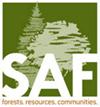利用激光雷达数据估算美国南部已造林的洼地橡树的生物量
IF 1.5
4区 农林科学
Q2 FORESTRY
引用次数: 0
摘要
密西西比河下游冲积河谷(LMAV)的低洼地阔叶林面积已经减少,像保护保护区计划(Conservation Reserve Program)这样的联邦项目鼓励在边缘农业区种植橡树,以提供生态系统服务。遥感技术,如光探测和测距(激光雷达),可以用来估计这些林分的生物量,从而有可能使土地所有者利用碳市场,但收集数据的成本很高。因此,我们确定了免费获得的低密度激光雷达数据是否可以捕获LMAV中树木和林分水平特征的变化,包括地上生物量。我们发现,多元回归激光雷达模型比林分水平参数捕获更多的变异,包括土壤类型的一般改进模型。预测树木和林分参数(树高、活树冠高、二次平均直径、树冠面积、每公顷乔木数、林分基面积和林分生物量)的r2模型值在0.34 ~ 0.82之间,均方根误差(RMSPE)在7% ~ 36%之间。具体而言,林分生物量模型的RMSE约为19 Mg/ha,约为各站点平均值的19%。因此,在LMAV中,免费获得的激光雷达数据可用于评估已造林的洼地橡树地点的树木和林分结构成分。研究启示:包括保护储备计划(CRP)在内的计划激励农民在森林和其他土地用途中种植边缘农田,以提供野生动物利益。特别是在减缓气候变化方面,植树造林可以额外吸收碳,并使土地所有者有可能利用碳市场。然而,碳量很难以有效和经济的方式在大面积上测量。像激光雷达这样的遥感技术可以估计森林碳储量,但数据收集需要传感器在森林地区上空飞行。然而,公开可用的激光雷达数据已经存在于海拔和洪水测绘中,并且可能对估计森林碳有用。我们发现,免费的激光雷达数据可以充分估计森林参数,这对估计碳储存和固存至关重要。本文章由计算机程序翻译,如有差异,请以英文原文为准。
Using LiDAR Data to Estimate Biomass in Afforested Bottomland Oak Sites in the Southern United States
The extent of bottomland hardwood forests in the Lower Mississippi Alluvial Valley (LMAV) has diminished, and federal programs like the Conservation Reserve Program provide incentives to afforest marginal agricultural areas with oaks to provide ecosystem services. Remote sensing technologies, like light detection and ranging (LiDAR), can be used to estimate biomass of these stands to potentially allow landowners to take advantage of carbon markets, but data are expensive to collect. Therefore, we determined whether freely available low-density LiDAR data could capture variability in tree- and stand-level characteristics in the LMAV, including aboveground biomass. We found that multiple regression LiDAR models captured more variability in tree-level than stand-level parameters and including soil type generally improved models. Model r2 values predicting tree and stand parameters including tree height, height to the live crown, quadratic mean diameter, crown area, trees per hectare, stand basal area, and stand biomass ranged from 0.34 to 0.82 and root mean square percent error (RMSPE) ranged from 7% to 36%. Specifically, models for stand biomass had an RMSE of about 19 Mg/ha or about 19% of mean values across sites. Therefore, freely available LiDAR data was useful in evaluating afforested bottomland oak sites for tree- and stand-level structural components in the LMAV.
Study Implications: Programs including the conservation reserve program (CRP) incentivize farmers to plant marginal farmland in forests and other land uses to provide wildlife benefits. In particular regard to mitigating climate change, afforestation could additionally uptake carbon and allow landowners to potentially take advantage of carbon markets. However, carbon amounts are difficult to measure over large areas in an efficient and cost-effective way. Remote sensing technologies, like LiDAR, could estimate forest carbon storage, but data collection requires the sensor to be flown aerially over forested areas. However, publicly available LiDAR data already exist for elevation and flood mapping and might additionally be useful to estimate forest carbon. We found that free LiDAR data could adequately estimate forest parameters important for the estimation of carbon storage and sequestration.
求助全文
通过发布文献求助,成功后即可免费获取论文全文。
去求助
来源期刊

Forest Science
农林科学-林学
CiteScore
2.80
自引率
7.10%
发文量
45
审稿时长
3 months
期刊介绍:
Forest Science is a peer-reviewed journal publishing fundamental and applied research that explores all aspects of natural and social sciences as they apply to the function and management of the forested ecosystems of the world. Topics include silviculture, forest management, biometrics, economics, entomology & pathology, fire & fuels management, forest ecology, genetics & tree improvement, geospatial technologies, harvesting & utilization, landscape ecology, operations research, forest policy, physiology, recreation, social sciences, soils & hydrology, and wildlife management.
Forest Science is published bimonthly in February, April, June, August, October, and December.
 求助内容:
求助内容: 应助结果提醒方式:
应助结果提醒方式:


